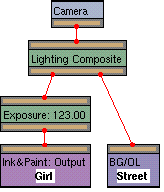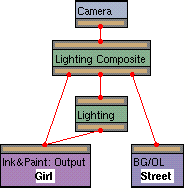Procedure for using lighting effects
To use lighting effects in a scene, you should add a single Lighting Composite node immediately beneath the Camera node:

Then add all the other elements of the scene, connecting each one to the Lighting Composite node, rather than to the Camera node. Add Lighting or Exposure nodes as necessary.
For example, for a traditional backlighting effect with no blurring or tinting you would use the Exposure node:

Remember that you can use the Lighting node to blur and tint its input. Using this feature, it's easy to add a colored glow behind a character:

The character (i.e. the output from the Ink & Paint node) is used twice: via the Lighting node to create the glow, and direct to the Lighting Composite node to superimpose the character over the glow.